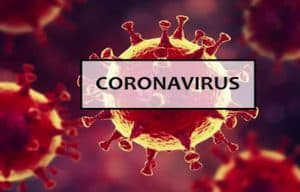COVID cases rise in Monroe County
The coronavirus continued its recent spread in Monroe County, with 32 new cases reported over the past week.
There are 66 cases active in the county, while the death toll remains at 13.
The state is still counting the woman in her 80s who had the virus and died but tested negative right before she died, while Monroe County is not.
Seven residents are currently hospitalized or in a rehabilitation facility due to COVID-19.
Three cases were announced Saturday, two cases were reported Sunday, another seven new cases were reported Monday and six were reported Tuesday. That comes after five cases were announced Friday, two of which were from one family. Eight cases were reported Thursday, including four from the same household. A case was also reported last Wednesday, bringing the county total to 168 confirmed cases since the pandemic began.
Monroe County Health Department Administrator John Wagner said his office does not track how many cases are symptomatic vs. asymptomatic.
“That would be difficult to determine because some/many are tested and do not have symptoms at the time of test but are not truly asymptomatic because they develop symptoms later,” Wagner explained.
Wagner attributes the recent case spike in Monroe County to a combination of factors.
“From what I can tell, it is a little of everything,” he said. “We have more testing, things open with more risk, and spread in individual households is very hard to prevent.”
In related news, Walmart in Waterloo began requiring customers to wear masks while in the store, effective Thursday.
“COVID-19 protocols have continued to adapt during the pandemic in response to evolving research and mandates spanning the country. Additional safety changes took effect July 9 to expand our efforts in reminding customers of the importance and necessity of wearing face coverings in our stores,” said Casey Staheli, a senior corporate communications manager for the retailer.
Some of the changes include additional signage and additional training for some Walmart associates who will assist with COVID-related issues.
“We want everyone to be safe,” Staheli added.
Among the recent cases was an employee at Hopskeller Brewing Company, 116 E. Third Street in Waterloo. A member of Hopskeller’s kitchen staff who does not reside in this county tested positive for the virus.
The bar reopened the next day with entirely new staff and Hopskeller worked with the health department to ensure the safety of employees and customers. Hopskeller said it plans to reopen its kitchen service this Tuesday.
On July 5, Monroe County Clerk Jonathan McLean said an employee of his office at the courthouse had recently tested positive for COVID-19 and in accordance with health guidelines, the clerk’s office would be closed. For emergency requests, email countyclerk@monroecountyil.gov.
McLean told the Republic-Times on Monday that his office will reopen Wednesday at 8 a.m. after no other employees tested positive for the virus.
According to the IDPH, the Waterloo zip code has had 81 confirmed cases (1,463 tests), the Columbia zip code has had 72 cases (643 tests) and the Valmeyer zip code has had 14 cases (108 tests).
To the north, St. Clair County has 2,654 confirmed cases, including 147 coronavirus-related deaths. A total of 23,928 people have been tested there.
To the south, Randolph County has had 328 confirmed cases, 37 of which are active. Seven people have died from the virus, 284 have recovered and none are hospitalized with it in that county.
Across the region, the spread of the virus has slightly picked up, though it is still relatively slow.
In the southern region of the state, there is a positivity rate of 5 percent, a 3 percent increase in positivity rates and a 61 percent drop in hospital admissions for coronavirus-like illnesses in the last 14-28 days.
The region also has a 43 percent medical and surgical bed capacity, 51 percent ICU bed availability and 79 percent ventilator availability.
The IDPH county-specific tool designed to help individuals determine what activities they choose to do measures the risk metrics of new cases per 100,000, number of deaths, test positivity percentage, number of test performed, emergency department visits for COVID-19-like illnesses, hospital admissions for COVID-19-like illnesses, cluster percentage of cases and percentage of ICU beds available.
For all of the metrics save cluster percentage of cases, the state lists a target number and shows whether a county meets that target or exceeds. Monroe County meets all targets as of this week.
There are 155,506 cases of coronavirus and 7,218 deaths in all of Illinois, according to the IDPH.
The IDPH reported 707 more cases and 25 more deaths on Tuesday. 883 new cases and six new deaths on Monday. There were 1,317 additional cases and 25 additional deaths on Friday. There were 1,018 more cases and 20 more deaths on Thursday. There were 980 new cases and 36 new deaths on Wednesday.
In Missouri, there were 28,826 confirmed cases and 1,093 deaths as of Tuesday. That includes 7,851 cases in St. Louis County and 2,919 cases in St. Louis City, according to the Missouri Department of Health & Senior Services.
Nationally, more than 3,412,484 people have contracted the virus, while 135,936 people have died.
Worldwide, there are over 13.1 million cases of coronavirus and at least 574,218 COVID-19-related deaths.
The Republic-Times has obtained and analyzed data from the Monroe County Health Department that helps provide a slightly deeper understanding of the coronavirus here.
The data includes the age of all 136 residents who had contracted the virus as of July 7, along with when their positive results came in.

Based on recent numbers, the average age of people with COVID-19 in Monroe County is approximately 54.3, which Wagner said makes sense.
“That number is not surprising and fits in around the national numbers,” he said.
While the Centers for Disease Control and Prevention does not list the average age of America’s over 11 million coronavirus cases, the latest study shows the median age is 48.
The median is the middle number in a sequence when all numbers are arranged in ascending order.
The health department’s data also shows the highest weekly cases occurred the week beginning April 5, while the third highest number of new cases came the week before that. Those weeks saw 26 and 16 more COVID cases, respectively.
Although it can seem that was the peak of the virus here, Wagner said that may be too simple.
“Peak dates will be hard to determine because, with such low numbers, an individual outbreak or a large family getting it would affect the scenario,” he said.
“With our low caseload, trying to determine trends or peaks is difficult with such a small sample size,” Wagner added.
Still, the numbers paint a slightly clearer picture of the pandemic in Monroe County.
The second highest number of cases came the week of June 21, when 17 new cases were reported here.
Wagner explained that was due to an “increase in testing at nursing homes and (the) public.”
At the end of March and beginning of April, the majority of cases were among seniors. Of the 42 new cases in those two weeks, 26 (62 percent) were among people 60 and older.
In the week of June 21, however, only one case was reported among that age group.
Wagner attributed those shifting demographics to the initial outbreak at Garden Place Senior Living in Columbia skewing the numbers in those two early weeks, while testing of medical workers contributed to younger people testing positive for the virus.
“Medical workers contracting COVID after (the) initial wave had medical worker cases increase in early-mid June,” Wagner said.
The virus also seemed to be detected more in young people in June than it had been so far.
For the month of June, the county saw 32 additional coronavirus cases.
Three of those were among children younger than 10, four were among teenagers and six were among people in their 20s. The county also saw its youngest case of COVID, as a 2-month-old baby tested positive for the virus June 25.
In other words, about 41 percent of the confirmed cases were among people under 30.
Wagner told the Monroe County Board on Monday that it appears more young people are getting the virus, identifying them as “risk-takers.”
In that same timeframe, there was only one case each among people in their 60s, 70s and 90s and none among people in their 80s or over 100. That means only about 9 percent of June’s COVID cases were among the age groups most susceptible to the virus.
The most common age group for COVID cases, however, was still people in their 50s, as there were 10 cases (31 percent of total cases) in that demographic over that period.
In the other middle-age ranges, there were just three cases each of people in their 30s and 40s testing positive for the virus in June. Those two age groups combined for only about 18 percent of Monroe County’s cases, which means approximately 59 percent of cases were in people younger than 50.
Although these numbers suggest the virus has become more prevalent among the younger population in recent weeks, Wagner again stressed the difficulty of making a conclusive determination about trends with such a small sample size.
“With our low numbers, an outbreak at a nursing home can make it appear that the older population was more common during a certain time than it is for the general public, or an outbreak in one or two households can reduce the age range for a given time,” he explained.






